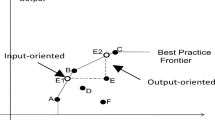Abstract
To investigate hedging effectiveness of multinational companies in respect of using currency derivatives, the author adapts an innovative and multi layers GJR-GARCH-based model. This model broke down the currency risk faced by MNCs in each business area and added six control variables other than foreign sales ratio, all these variables have been proved to be related to MNCs’ currency risk exposure but was not included into previous models. Moreover, this model absorbs advantages of several models built in previous studies and combines them into a whole, intact model. This paper also employed a wide research scope, using a sample of 48 non-financial and 28 financial firms headquartered in USA. Also, comparison between financial and non-financial firms is an innovation of our research. According to the result, hedging of non-financial companies in respect of currency risk is ineffective, and financial companies are more likely using currency derivatives to speculate.
Similar content being viewed by others
References
Ahmed, H., A. Azevedo, and Y. Guney. 2013. The effect of hedging on firm value and performance: evidence from the nonfinancial UK firms. European Financial Management 44: 1–31.
Allayannis, G., J. Ihrig, and J.P. Weston. 2001. Exchange-rate hedging: financial versus operational strategies. American Economic Review 91 (2): 391–395.
Bahoo, S., S. Khan, and M.A. Kanju. 2018. Do derivatives increase American corporate’s financial performance? City University Research Journal 8 (2): 219–235.
Bartram, S.M. 2004. Linear and nonlinear foreign exchange rate exposures of German nonfinancial corporations. Journal of International Money and Finance 23 (4): 673–699.
Ben-David, T.A. 2013. The effectiveness of hedging foreign exchange rate risk: an emerging market perspective (Doctoral dissertation).
Choi, J.J., and A.M. Prasad. 1995. Exchange risk sensitivity and its determinants: a firm and industry analysis of US multinationals. Financial Management 77–88.
Döhring, B. 2008. Hedging and invoicing strategies to reduce exchange rate exposure-a euro-area perspective (No. 299). Directorate General Economic and Financial Affairs (DG ECFIN), European Commission.
Fiskara Indawan, Sri Fitriani, Indriani Karlina, and Melva Viva Grace. 2015. The role of currency hedging on firm performance: a panel data evidence in Indonesia. Bulletin of Monetary Economics and Banking, Bank Indonesia, 17(3): 1–20, January.
Gilson, S.C., and J.B. Warner. 1997. Junk bonds, bank debt, and financing corporate growth. Bank Debt, and Financing Corporate Growth (October 1997).
Guo, M., L. Lu, L. Sheng, and M. Yu. 2018. The day after tomorrow: evaluating the burden of Trump’s trade war. Asian Economic Papers 17 (1): 101–120.
Handayani, H., H. Muharam, W. Mawardi, and R. Robiyanto. 2018. Determinants of the stock price volatility in the Indonesian manufacturing sector. International Research Journal of Business Studies 11 (3): 179–193.
He, J., and L.K. Ng. 1998. The foreign exchange exposure of Japanese multinational corporations. The Journal of Finance 53 (2): 733–753.
Hendrawan, R. 2017. Forward, forward option and no hedging which one is the best for managing currency risk? Journal Keuangan dan Perbankan 21(3).
Jorion, P. 1990. The exchange-rate exposure of US multinationals. Journal of Business 331–345.
Koutmos, G., and A.D. Martin. 2007. Modeling time variation and asymmetry in foreign exchange exposure. in Journal of Multinational Financial Management 17(1): 61–74. February 2007.
Mariana Vila Nova, António Melo Cerqueira, and Elísio Brandão. 2015. Hedging with derivatives and firm value. FEP Working Papers 568, Universidade do Porto, Faculdade de Economia do Porto.
MuchokiMwangi, A., and S. Mohamed. 2019. Effectiveness of external hedging technique on foreign currency exposure of the oil marketing companies in Kenya.
Muiru, Monica, Kisaka, Sifunjo, and Kalui, Fredrick. 2018. Effect of foreign exchange risk hedging techniques on financial performance of listed firms in Kenya. International Journal of Accounting and Financial Reporting 8(3).
Muller, A., and W. Verschoor. 2006. Asymmetric foreign exchange rate exposure: evidence from U.S. multinational firms. Journal of Empirical Finance, Elsevier, vol. 13(4–5), pp. 495–518, October.
Nance, D.R., C.W. Smith Jr., and C.W. Smithson. 1993. On the determinants of corporate hedging. The journal of Finance 48 (1): 267–284.
Nzioka, O.M., and F.M. Maseki. 2017. Effects of hedging foreign exchange risk on financial performance of non-banking companies listed at the nairobi securities exchange. European Scientific Journal 13(10).
Author information
Authors and Affiliations
Corresponding author
Ethics declarations
Conflict of interest
I, Zhang Xinbo, the only author of this paper, states here that there is no conflict of interest within this paper.
Rights and permissions
About this article
Cite this article
Zhang, X. Multinational Companies’ Hedging Effectiveness of Foreign Exchange Risk: A Quantitative Comparison Study. Fudan J. Hum. Soc. Sci. 14, 285–302 (2021). https://doi.org/10.1007/s40647-020-00305-3
Received:
Accepted:
Published:
Issue Date:
DOI: https://doi.org/10.1007/s40647-020-00305-3




